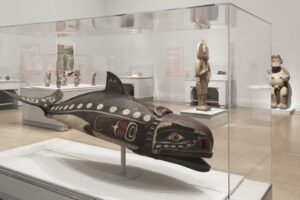
Photograph of the Climate in Crisis exhibit, taken by Johnathan Dorado. The exhibit features works of Indigenous artists across the Americas, offering a variety of perspectives on the threat climate change poses to Indigenous ways of life (from the Brooklyn Museum, 2020).
- Climate in Crisis: Environmental Change in the Indigenous Americas was an exhibit at the Brooklyn Museum from February 2020 to November 2023 showcasing Indigenous art from all over the Americas, specifically focusing on pieces that express Indigenous knowledge and perceptions of the environment, or how climate change threatens Indigenous ways of life.
- The exhibit is divided broadly into North, Central, and South American Indigenous art, then within each group by smaller regions, focusing on specific regional environmental issues.
- A key concept in the exhibit is “environmental colonialism”, or how colonial actions like land seizures, industrial development, and resource exploitation have impacted Indigenous communities politically and economically. While man-made climate change has only occurred since the start of the Industrial Revolution in the 1800s, the patterns of behavior that led to it have existed for longer, and were often present in colonialist enterprises.
How is this related to climate?
- The Canadian and Arctic section of the exhibit features imagery of animals, hunting, and fishing, which are integral to survival in the harsh environment (image below). In the 1700s, the introduction of commercial whale hunting by European colonizers, as well as unsustainable hunting of important animals like the caribou, created an imbalance in the Arctic ecosystem. With global warming, the very foundations of Arctic ecosystems – permanently frozen or multiyear ice – is melting, disturbing the migration patterns of animals, regional biodiversity, and the safety of the people who live on the ice.
- Researchers at the University of Washington and California Institute of Technology have found that the Arctic has lost about a third of its winter sea ice volume, especially older, multiyear sea ice, between 2004 and 2022.
- To learn more about the effects of sea ice melting, check out our entries on Sea Level Rise and Coastal Flooding,“Elegy for the Arctic” by Ludovico Einaudi, and Effects of Colonization and Climate Change on Indigenous Languages.
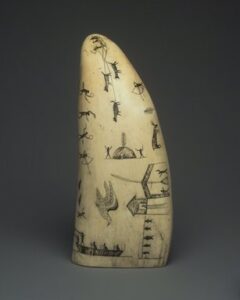
Alaska Native. Engraved Whale Tooth, late 19th century. Sperm whale tooth, black ash or graphite, oil, 6 1/2 x 3 x 2 in. (16.5 x 7.6 x 5.1 cm). Brooklyn Museum.
This engraved sperm whale tooth from Alaska depicts various hunting scenes: men chasing a walrus, harpooning a whale, spearing a bear, and shooting arrows at a caribou. Because of the lack of vegetation in the Arctic, hunting is essential to survival. However, rising temperatures threaten the livelihoods of both Arctic ecosystems and societies (from the Brooklyn Museum, 2020).
- The Canadian and U.S. Northwest coast section of the exhibit also features imagery of sacred animals native to the region: orcas, ravens, whales, eagles, and salmon (image below). The overexploitation of the Pacific Northwest’s resources post-American western expansion, and subsequent climate change, have disrupted the salmon populations, leaving indigenous communities without a key component of their lifestyle.
- Research from the U.S. National Oceanic and Atmospheric Administration (NOAA) has found that the timing of salmon migration in the Pacific Northwest has changed in response to climate change, although the degree of change depends on the specific salmon species. Climate change is also altering salmon habitats, necessitating precautionary long-term conservation strategies.
- Traditionally, the migration of salmon upriver was an important part of Northwestern Indigenous life, both in the spiritual and ecological sense. The salmon would be called to move upriver by fires set in the grassy hills along the rivers, which also encouraged growth of plants eaten by elk or used for medicine. The grass burning was also an expression of gratitude to the salmon, who were allowed to pass through the river for four days before being fished.
- Indigenous botanist and poet Robin Wall Kimmerer explains the resonance of the ceremony in her book Braiding Sweetgrass: “The feasts of love and gratitude were not just internal emotional expressions but actually aided the upstream passage of the fish by releasing them from predation for a critical time. Laying salmon bones back in the streams returned nutrients to the system. These are ceremonies of practical reverence. The burning beacon is a beautiful poem, but it is a poem written physically, deeply on the land. People loved the salmon the way fire loves grass and the blaze loves the darkness of the sea.”
- Research from the U.S. National Oceanic and Atmospheric Administration (NOAA) has found that the timing of salmon migration in the Pacific Northwest has changed in response to climate change, although the degree of change depends on the specific salmon species. Climate change is also altering salmon habitats, necessitating precautionary long-term conservation strategies.
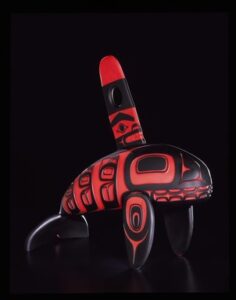
Preston Singletary (Tlingit, born 1963). Guardian of the Sea, 2004. Glass, 18 x 6 x 18 in. (45.7 x 15.2 x 45.7 cm). Brooklyn Museum. This glass sculpture depicts an orca whale, which is a crest figure or symbol of the artistPreston Singletary’s Tlingit clan. Habitat destruction and the decline of the Chinook salmon, which is the largest species of Pacific salmon and the whale’s primary food source, have threatened the Northwestern orca population (from the Brooklyn Museum, 2020).
- The Mississippi River Valley in the southern United States, was home to several prosperous outposts between 900 and 1650, when the “Little Ice Age” brought cooler temperatures and extreme weather to the region. Artifacts from those outposts illustrate Mississippian societies’ reactions to changes in climate. Works of modern Mississippi artists, included in the exhibit, focus on rising sea levels and local developments in oil and gas exploitation.
- The Climate Reality Project, a non-profit founded by Al Gore (a prominent U.S. politician and climate advocate/educator), has estimated that 75,000 people in the region are living in areas at risk of coastal flooding, with an additional 13,000 at risk by 2050, based on projected rises in the sea level. Additionally, more extreme weather events like hurricanes, more frequent flash floods, and higher temperatures are predicted for this area.
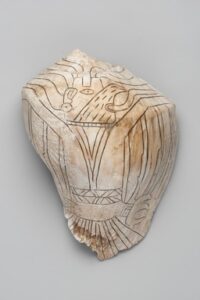
Mississippian. Engraved Conch Shell, 1200-1500 C.E. Conch shell, pigment, Falcon warrior: 10 7/16 × 7 1/2 × 5 1/2 in. (26.5 × 19.1 × 14 cm). Brooklyn Museum.
This engraved conch shell collected from Spiro Mound in Oklahoma, USA, depicts a falcon warrior with a speech scroll (or vomit from ritual purging) emanating from his mouth. Falcon-themed regalia was meant to connect the wearers with the realm of the sky, giving them special abilities. This conch would have been sourced from the coast of the Gulf of Mexico, gathered in an annual trip to the coast (from the Brooklyn Museum, 2020).
- Living in the arid southwestern U.S. requires intensive knowledge of the region’s ecological rhythms, since essential resources like water are scarce. The kachina, or ritual objects, displayed in the exhibit represent spirits of rain, which were necessary for growing crops (image below). Contemporary artwork from the region reflects struggles over Indigenous sovereignty and land. Protected areas with archaeological and cultural records have been reduced for fossil fuel and uranium mining.
- The U.S. Environmental Protection Agency (EPA) found in 2014 that in the previous 50 years, there has been less precipitation in the form of snow late in the winter, and the snow melt has occurred earlier, along with the maximum stream flow. In addition , total yearly streamflow has decreased in the decade prior. This lack of water has had severe effects on Indigenous communities in the region, drying up wells, decreasing the drinking water supply, and killing crops, livestock, and important medicinal and cultural plants.
- Uranium mining creates pollutants that can contaminate aquatic ecosystems for hundreds of years. The pollutants accumulate in the food chain and also threaten the supply of drinking water.
- The U.S. Environmental Protection Agency (EPA) found in 2014 that in the previous 50 years, there has been less precipitation in the form of snow late in the winter, and the snow melt has occurred earlier, along with the maximum stream flow. In addition , total yearly streamflow has decreased in the decade prior. This lack of water has had severe effects on Indigenous communities in the region, drying up wells, decreasing the drinking water supply, and killing crops, livestock, and important medicinal and cultural plants.
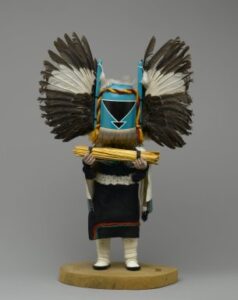
Seona. Kachina Doll (Angwusnasomtaqa [Crow Mother]), 1960-1970. Cottonwood root, acrylic paint, feathers, fur, hide, synthetic wool and yarn, painted canvas, 15 x 9 x 4 1/2 in. (38.1 x 22.9 x 11.4 cm). Brooklyn Museum.
Seona is an artist from the Pueblo and Hopi tribes. This kachina doll figure is a representation of an elemental/natural force, with the power to control the rain, crop growth, and fertility, as well as to cure and protect people. Such figures can serve both spiritual and educational purposes, given to people as rewards for virtuous behavior or to children as a religious lesson (from the Brooklyn Museum, 2020).
- Mexico and Guatemala were home to the ancient Olmec, Maya, and Aztec groups, who created a variety of objects with motifs connecting to the interactions between the spiritual and natural worlds (image below). That philosophy informs the work of Indigenous activists in the region today, fighting to protect their land from mining and logging companies.
- Mexico’s forests are “net carbon sinks”, meaning that they remove more greenhouse gasses like carbon dioxide than they emit. Deforestation contributes to climate change by removing carbon sinks like Mexico’s forests, leaving more greenhouse gasses in the atmosphere.
- Mexico’s geography makes it vulnerable to extreme weather events like tropical cyclones and floods, which have been occurring more frequently due to climate change. These, in turn, threaten the country’s transportation, water, and power infrastructure, as well as the agricultural and tourism industries in the region.
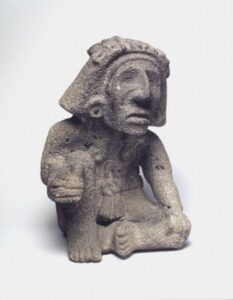
Aztec. Seated Figure of the Wind God (Ehecatl), ca. 1440-1521. Stone, 11 7/16 x 7 1/16 x 6 11/16 in. (27.1 x 17.9 x 17 cm). Brooklyn Museum.
This sculpture of Ehecatl, the Aztec god of the wind and rain, was found in Mexico. Smaller, more intimate figures like this one were probably adornments for sacred shrines, and were venerated during festivals celebrating stages of the agricultural cycle (from the Brooklyn Museum, 2020).
- Costa Rican, Panaman, and Colombian Indigenous art has similar themes to Central American art further north, but communities in this region also have to deal with more frequent hurricanes and extreme weather events.
- According to the Intergovernmental Panel on Climate Change (IPCC), 613 extreme climate and hydro-meteorological events such as typhoons and hurricanes, coastal storm surges, floods, drought, and heatwaves, have occurred from 2000 to 2013 in Latin America. These events have led to the destruction of habitats and the displacement of people.
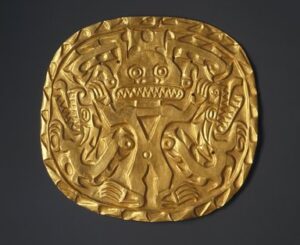
Coclé. Plaque with Crocodile Deity, ca. 700-900. Gold, 8 1/2 x 9 in. (21.6 x 22.9 cm). Brooklyn Museum.
This plaque of a crocodile god was made by the Coclé group in Panama. This god was most likely associated with strength and fertility, as well as the sun and water (from the Brooklyn Museum, 2020).
- Brazil, Colombia, Ecuador, and Peru in South America were home to several million Indigenous groups prior to the 1500s, but post-European colonization, only a few hundred survived in each country. Art from Indigenous people in the region, who are now fighting deforestation from mining, logging, and cattle ventures, is displayed in the exhibit as well.
- The Amazon rainforest is estimated to contain about 123 billion tons of carbon above and below ground, making it one of the most important carbon sinks on the planet. As more and more fossil fuels are burned, the Amazon has been moderating climate change by absorbing carbon from the atmosphere. However, about 17% of the rainforest has been converted into agricultural land, increasing the local temperature and vulnerability to fires, and decreasing the humidity and density of vegetation. This conversion makes the land more likely to emit carbon than to absorb it.
- Additionally, there are differences in how certain regions of the Amazon absorb and emit carbon dioxide. From 2001 to 2021, Indigenous lands in the rainforest were found to be net carbon sinks, removing 340 million metric tons of carbon from the atmosphere every year. On the other hand, areas of the Amazon not managed by Indigenous people (often used for logging, ranching, and farming) were net carbon sources, producing about 270 million metric tons, which is more than they absorbed.
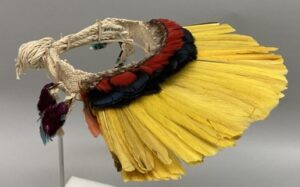
Kaapor. Man’s Headdress, 20th century. Feathers, cotton cords, bird skins, 10 x 10 1/2 x 1 1/2 in. (25.4 x 26.7 x 3.8 cm). Brooklyn Museum.
This feather headdress was made by the Ka’apor people in Brazil. The featherwork is inspired by a cultural hero, Maíra, who created the world and wears feathered regalia. Stories about Maíra and his feathered clothes teach children about the meaning of the ornaments: for example, blue feathers represent the sky and the supernatural beings that dwell there. The knowledge passed down in these oral traditions is important, but may be jeopardized by biodiversity losses from logging in the Amazon (from the Brooklyn Museum, 2020).
References and additional resources
- “Climate Impacts in the Southwest.”, climatechange.chicago.gov/climate-impacts/climate-impacts-southwest. Accessed 9 Nov. 2023.
- “Climate in Crisis: Environmental Change in the Indigenous Americas.” Brooklyn Museum, 2020. https://www.brooklynmuseum.org/opencollection/exhibitions/3391.
- “Climate Change Impacts in Latin America.” WWF, www.wwfca.org/en/our_work/climate_change_and_energy/climate_change_impacts_la/. Accessed 9 Nov. 2023.
- Fisheries, NOAA. “New Research Asks, ‘Can Pacific Salmon Keep Pace with Climate Change?’” NOAA, 16 May 2023, www.fisheries.noaa.gov/news/new-research-asks-can-pacific-salmon-keep-pace-climate-change
- K. Eugenia. “Climate in Crisis: Climate in Crisis: Environmental Change in the Indigenous Americas. Exhibit at the Brooklyn Museum.” Museum Anthropology, vol. 45, no. 2, 2022, pp. 195–197, https://doi.org/10.1111/muan.12252.
- Kiest, Kristina. “Deforestation, Warming Flip Part of Amazon Forest from Carbon Sink to Source.” NOAA Research, 21 Feb. 2023, research.noaa.gov/2021/07/14/deforestation-warming-flip-part-of-amazon-forest-from-carbon-sink-to-source/.
- Kimmer, Robin W. Braiding Sweetgrass. Milkweed Editions, 2020.
- “Mexico Climate Change Country Profile: Fact Sheet: Latin America & the Caribbean.” U.S. Agency for International Development, 17 Mar. 2023, www.usaid.gov/climate/country-profiles/mexico.
- Mitchell, Jerry. “Climate Change Impact on Mississippi: What We Can Expect?” Mississippi Center for Investigative Reporting, Mississippi Center for Investigative Reporting, 7 Sept. 2022, www.mississippicir.org/news/climate-change-impact-on-mississippi-what-we-can-expect.
- Robbins, Jim, et al. “Indigenous Lands among the Amazon’s Last Carbon Sinks.” Yale E360, 17 Jan. 2023, https://e360.yale.edu/digest/indigenous-amazon-carbon-sinks.
- Sayej, Nadja. “How Artwork Shows the Impact of Climate Crisis on Indigenous Americans.” The Guardian, Guardian News and Media, 9 Mar. 2020, www.theguardian.com/artanddesign/2020/mar/09/brooklyn-museum-indigenous-artwork-exhibition.
- Uranium, https://www.biologicaldiversity.org/programs/public_lands/energy/dirty_energy_development/uranium/.
- UW News Staff. “Newest Satellite Data Shows Remarkable Decline in Arctic Sea Ice over Just Three Years.” UW News, 10 Mar. 2022, https://www.washington.edu/news/2022/03/10/newest-satellite-data-shows-remarkable-decline-in-arctic-sea-ice-over-just-three-years/.
